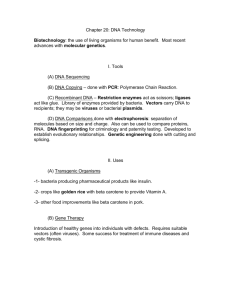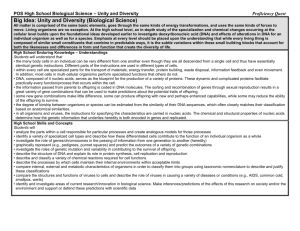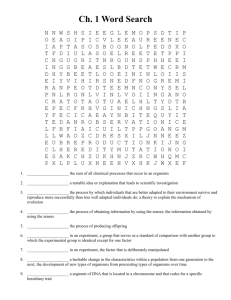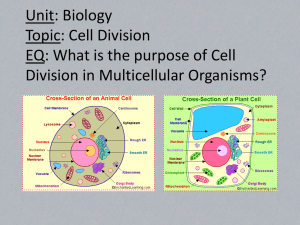Benchmark Test Questions 2012
advertisement
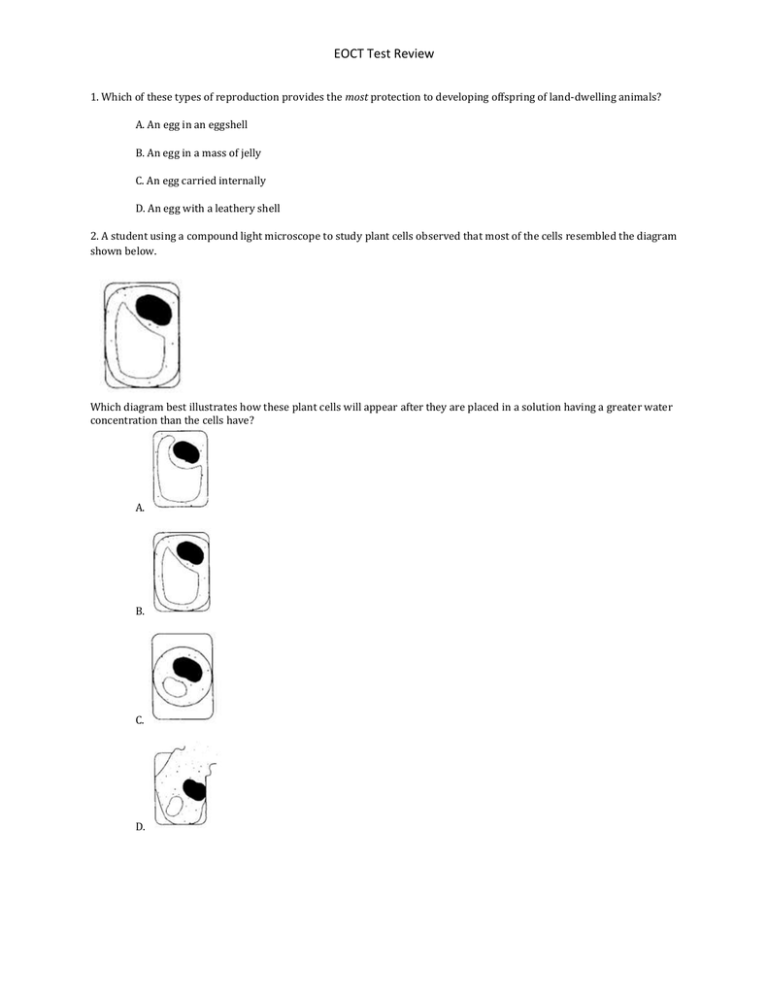
EOCT Test Review 1. Which of these types of reproduction provides the most protection to developing offspring of land-dwelling animals? A. An egg in an eggshell B. An egg in a mass of jelly C. An egg carried internally D. An egg with a leathery shell 2. A student using a compound light microscope to study plant cells observed that most of the cells resembled the diagram shown below. Which diagram best illustrates how these plant cells will appear after they are placed in a solution having a greater water concentration than the cells have? A. B. C. D. 3. Which process is illustrated in the diagram below? A. Meiosis B. Direct harvesting C. Chromatography D. Genetic engineering 4. Which occurrence is a major source of the gases that can produce acid rain? A. Burning of fossil fuels B. A hole in the ozone layer C. Cloud-seeding by airplanes D. Emissions by nuclear reactors 5. Some cells, such as human nerve and muscle cells, contain many more mitochondria than do other cells, such as skin cells. Why do some cells have more mitochondria than others? A. The cells use more energy. B. The cells store more nutrients. C. The cells divide more frequently. D. The cells degrade more proteins. 6. Study the picture below. Which characteristic supports the hypothesis that this bird spends a great deal of time in the trees and shrubs? A. The shape of its feet B. The color of its wings C. The thickness of its bill D. The crest of feathers on its head 7. Which of the following pathways of energy flow would give the final consumer the smallest percentage of original energy available in a food chain? A. Grass → grasshopper → robin → hawk B. Grass → grasshopper → frog → snake → hawk C. Grass → mouse → wolf D. Grass → mouse →snake → hawk 8. A possible conclusion based on the modern theory of evolution is that: A. Most species have changed. B. All living things developed from fish. C. Most plants and animals can interbreed. D. All dogs are more closely related to fish than to whales. 9. When checking shell color for a species of snail found only in a remote area seldom visited by humans, scientists discovered the distribution of individuals that is shown in the graph below. Based on the information shown in the graph, the snail population is undergoing A. Artificial selection B. Disruptive selection C. Stabilizing selection D. Directional selection 10. Wetlands are very specialized ecosystems. Of the following causes of wetland loss, which do people have the LEAST control over? A. Droughts B. Overgrazing C. Draining and filling D. Discharge of pollutants 11. The LEAST genetic variation will probably be found in the offspring of organisms that reproduce using A. Meiosis to produce gametes B. Mitosis to produce a larger population C. Internal fertilization to produce an embryo D. Fusion of eggs and sperm to produce zygotes 12. It has been observed that the proportions of adenine and thymine bases in a DNA molecule are equal, as are the proportions of cytosine and guanine. This is best explained by A. Helical base structure B. Identical base substitution C. Complementary base pairing D. Antiparallel base arrangement 13. Gymnosperms (a group of plants including conifers) and angiosperms (flowering plants) share many traits but are classified in separate groups. Which is a difference between gymnosperms and angiosperms? A. Only angiosperms form wood. B. Only angiosperms produce seeds within fruits. C. Only gymnosperms have vascular tissue. D. Only gymnosperms reproduce with spores. 14. Some snake embryos have small buds resembling limbs. These buds disappear at later stages of embryo development. These findings suggest that these snakes A. had a parent with limbs B. will have offspring with limbs C. have functional limbs as adults D. evolved from an ancestor that had limbs 15. Which of the following is most consistent with the modern theory of evolution? A. Life on this planet came from another planet far out in space. B. Living organisms have not changed for hundreds of millions of years. C. Parents change their traits in order to survive in the environment; then those parental traits are passed on to their offspring. D. Through their genes, parents pass their traits to their offspring; those offspring with traits that help them survive in the environment are better able to reproduce. 16. Viruses are exceptions to the cell theory, but they have some characteristics of living things. What is one of these characteristics? A. They contain chlorophyll. B. They reproduce by mitosis. C. They contain genetic material. D. They are made up of many specialized cells. 17. A group of students measured the volume of air they exhaled during three different activities: sitting, walking, and running. The volume of exhaled air is directly related to the amount of carbon dioxide produced. The data the students collected are summarized in the graph below. Which of these statements BEST explains the data? A. As metabolism increases, the amount of carbon dioxide produced decreases. B. As metabolism increases, the amount of carbon dioxide produced increases. C. The rate of metabolism depends on the amount of carbon dioxide produced. D. The amount of carbon dioxide remains constant as metabolism increases. 18. Research indicates that many plants prevent the growth of other plants in their habitat by releasing natural herbicides (chemicals that kill plants). These substances are known as allelochemicals and include substances such as quinine, caffeine, and digitalis. Experiments have confirmed that chemicals in the bark and roots of black walnut trees are toxic, and when released into the soil they limit the growth of crop plants such as tomatoes, potatoes, and apples. Allelochemicals can alter growth and enzyme action, injure the outer cover of a seed so the seed dies, or stimulate seed growth at inappropriate times of the year. Studies on allelochemical effects help explain the observation that almost nothing grows under a black walnut tree even though light and moisture levels are adequate for growth. Which phrase best predicts the relative numbers of different plant species in regions A, B, and C in the diagram shown below? A. Greater in C than B B. Greater in A than C C. Greater in A than B D. Greater in B than C 19. One strand of DNA could be as long as a football field if it were stretched out lengthwise. One of the factors allowing DNA to fit inside the nucleus of a cell is its ability to A. Break apart into separate genes B. Coil tightly around associated proteins C. Denature from the effect of an enzyme D. Extend to form very long, thin molecules 20. The praying mantis is a predatory insect that often eats moths. The graph below shows the relative numbers of two species of moths over 12 weeks after the introduction of the predatory praying mantis. What characteristic of this ecosystem is BEST indicated from this graph? A. Species B was preferred as food over species A. B. Species B may replace species A in this environment. C. Species B will reproduce more rapidly than species A. D. Species B was more abundant at the beginning of this time period than species A. 21. In one of the steps of the carbon cycle, a person exhales a molecule of carbon dioxide ( ) into the atmosphere. Which of the following is MOST LIKELY to happen next to the atom of carbon in this molecule? A. It may be used as part of a sugar in a plant. B. It may become part of a protein in an animal. C. It may be consumed as a fossil fuel is burned. D. It may be decomposed into carbon and oxygen by a bacterium. 22. Base your answers to the next two questions on the diagram below, which represents some biochemical reactions involved in a cellular process, and on your knowledge of biology. The molecule coded directly from DNA is represented by number A. 1 B. 2 C. 3 D. 4 23. Base your answers to the next two questions on the diagram below, which represents some biochemical reactions involved in a cellular process, and on your knowledge of biology. What is an example of a molecule produced by this type of process? A. Glucose B. A protein C. Glycogen D. A fatty acid 24. ATP molecules store energy for cellular activity. When the bond holding the third phosphate is broken, A. all cellular activity stops B. energy is released and changes ATP to ADP C. energy dissipates and metabolic functions increase D. tRNA picks up the phosphate for protein synthesis 25. A single cell and a multicellular organism are represented below. Which structures are correctly paired with their primary function? A. A and G - transmission of nerve impulses B. B and E - photosynthesis C. C and H - digestion of food D. D and F - gas exchange 26. The diagram below shows the relative concentration of molecules inside and outside of a cell. Which statement best describes the general direction of diffusion across the membrane of this cell? A. Oxygen would diffuse into the cell. B. Glucose would diffuse into the cell. C. Protein would diffuse out of the cell. D. Carbon dioxide would diffuse out of the cell. 27. Which of the following is NOT a part of Darwin's theory of evolution by natural selection? A. Individuals in a population vary in many ways. B. More offspring are produced than can generally survive. C. Changes in an individual's genetic material are usually harmful. D. Some individuals possess features that enable them to survive better than individuals lacking those features. 28. The human Genome Project was begun in 1988 by scientists from 13 nations as a worldwide effort to understand the sequencing of all DNA in the human body. What is one potential scientific benefit of this research? A. It will help to explain human cultural differences. B. It will create communication between research centers. C. It will help find the genes responsible for many diseases. D. It help to classify man most accurately in the animal kingdom. 29. Due to a genetic problem, the cells of a very young plant that has just sprouted from a seed do not produce any carbohydrates. The plant is most likely to die young because A. It will not have energy to carry out metabolic processes necessary for growth. B. It will not be able to produce a cell wall around the boundaries of its cells. C. It will not have proteins to form lignin. D. Both statements A and B are correct. 30. Which of the following is an example of micro-evolution in organisms? A. Speciation B. Habitat selection C. Bio-magnification D. Pesticide resistance 31. The organisms in a typical backyard are likely to include bacteria, grass, shrubs, trees, insects,spiders, birds, and small mammals. Together, all these organisms make up A. A kingdom B. A population C. A community D. An experimental group 32. The evolutionary pathways of seven living species are shown in the diagram below. Which two species are likely to have the most similar DNA base sequences? A. B and G B. E and G C. B and C D. C and D 33. The diagram below shows the effect of spraying a pesticide on a population of insects over three generations. Which concept is represented in the diagram? A. Extinction B. Succession C. Survival of the fittest D. Dynamic equilibrium 34. In 1883, Thomas Engelmann, a German botanist, exposed a strand of algae to different wavelengths of light. Engelmann used bacteria that concentrate near an oxygen source to determine which sections of the algae were releasing the most O2. The results are shown below. Which statement is a valid inference based on this information? A. Respiration rate in the bacteria is greatest at 550 nm. B. Photosynthetic rate in the algae is greatest in blue light. C. The algae absorb the greatest amount of oxygen in red light. D. Oxygen production decreases as the wavelength of light increases from 550 to 650 nm. 35. A DNA nucleotide may be made up of a phosphate group, along with ______. A. deoxyribose sugar and uracil B. deoxyribose sugar and guanine C. ribose sugar and cytosine D. ribose sugar and adenine 36. This seed is best dispersed by A. Birds B. Wind C. Water D. Insects 37. The jimsonweed Datura stramonium normally has 12 chromosomes in the body cells. How many chromosomes will an egg cell of the weed have? A. 6 chromosomes B. 12 chromosomes C. 18 chromosomes D. 24 chromosomes 38. Which of the organisms shown below is NOT correctly labeled with its kingdom? A. B. C. D. 39. Which organism is heterotrophic? A. Moss B. Algae C. Oak tree D. Mushroom 40. A series of investigations was performed on four different plant species. The results of these investigations are recorded in the data table below. Characteristics of Four Plant Species Based on these data, which two plant species appear to be most closely related? A. A and B B. A and C C. B and D D. B and C 41. Cytochrome c is an enzyme located in the mitochondria of many types of cells. The number of differences in the amino acid sequences of Cytochrome c from different species are compared to human Cytochrome c in the data table below. Of the organisms listed below, which one has a DNA code for Cytochrome c that is most similar to that of a human? A. Tuna B. Moth C. Dog D. Chicken 42. After a volcanic eruption has covered an area with lava, which of the following is the MOST likely order of succession in the repopulation of the area? A. lichens grasses shrubs trees B. mosses grasses lichens trees C. grasses trees D. shrubs grasses mosses lichens trees lichens 43. Conservationists suggest that discarded newspapers be used to cover areas under mulch in order to keep out the growth of unwanted plants such as weeds. Over time, these newspapers will break down and will need to be replaced. Although black plastic is sold for this purpose, conservationists favor the use of newspapers. What explanation based on a science principle supports this recommendation? A. The newspapers will return nutrients to the soil as they break down. B. Conservationists want to prevent plastic makers from making money. C. Newspapers are stronger than plastic and will prevent weed growth longer. D. Black plastic is frequently covered with seeds and spores that may cause more weeds to grow. 44. ATG is ________, while UAA is ________. A. a ribosome - a protein B. an amino acid - an enzyme C. a DNA codon - an RNA codon D. transfer RNA - messenger RNA 45. Which of these chromosomal mutation diagrams shows a deletion mutation? A. B. C. D. 46. 5' ATCAGCGCTGGC 3' The above sequence of DNA is part of a gene. How many amino acids are coded for by this segment? A. 4 B. 8 C. 12 D. 20 47. A student is making a model to demonstrate how cells respond to solutions with varying concentrations of different materials. She soaked a kidney bean in distilled water until it started to swell. For the demonstration, she wants to put the swollen bean in a solution that would cause the bean to shrivel but not corrode. In what kind of solution should she put the swollen bean? A. A solution with a very low pH. B. A solution with a very high pH. C. A solution with a very low concentration of salt. D. A solution with a very high concentration of salt. 48. The diagram below represents an energy pyramid constructed from data collected from an aquatic ecosystem. Which statement best describes this ecosystem? A. The ecosystem is most likely unstable. B. Long-term stability of this ecosystem will continue. C. The producer organisms outnumber the consumer organisms. D. The herbivore populations will continue to increase in size for many years. 49. Animals that are the LEAST specialized generally stand the best chance of survival when the environment suddenly and drastically changes because they are able to A. Mutate rapidly B. Reproduce abundantly C. Move from place to place D. Adapt to different conditions 50. Protein synthesis is a major function of living cells. The type of protein synthesized by a cell is determined by the sequence of ________. A. Lipids B. Enzymes C. Amino acids D. Carbohydrates 51. A. It has a cell membrane. B. It has ribosomes to make proteins. C. It has no membrane-bound nucleus. D. It stores genetic information in DNA. 52. The diagram below represents a structure involved in cellular respiration. The release of which substance is represented by the arrows? A. DNA B. Oxygen C. Glucose D. Carbon dioxide 53. Sometimes a section of a chromosome is lost during meiosis. This loss results in a change in genetic material known as ____________. A. a deletion B. polyploidy C. a replication D. crossing-over 54. The diagram below represents a cell. The letters in the diagram represent alleles for two different genetic traits. According to Mendel's law of independent assortment, which of the following shows all of the allele combinations expected in gametes produced by this cell? A. B. C. D. 55. Which of the diagrams below shows and example of secondary succession in an ecosystem? A. B. C. D. 56. The flying squirrel of North America closely resembles the flying phalanger of Australia. They are similar in size and have long, bushy tails and skin folds that allow them to glide through the air. The squirrel is a placental mammal, while the phalanger is a marsupial. These close resemblances, even though genetically and geographically separated by great distances, can best be explained by A. Divergent evolution B. Vestigial structures C. Convergent evolution D. Spontaneous generation 57. One early spring morning, Reva went to her car to go to school. She noticed that the entire car was covered with a thin layer of yellow-green pollen. Each sperm that is a part of a pollen grain was created by what type of cell division? A. Meiosis B. Mitosis C. Budding D. Nuclear fission 58. To break down carbohydrates outside of the human body requires heat at a temperature close to that of a burning match. However, inside the human body, carbohydrates are burned at normal body temperatures using enzymes. The biological conclusion from this statement is that A. Enzymes supply all of the energy required to burn carbohydrates in the human body. B. Enzymes work to help reduce the energy required to burn carbohydrates in the human body. C. The human body has strong heat insulation; that is why it does not feel the burning of carbohydrates. D. The energy to burn carbohydrates in the human body comes directly from the sun and is absorbed into the body. 59. For many years scientists debated whether viruses should be considered living organisms. Which statement could a scientist use to support the position that viruses are not living? A. Viruses have genes encoded in DNA. B. Viruses infect both plant and animal cells. C. Viruses replicate to produce more viruses. D. Viruses require a host cell in order to reproduce. 60. There are many different enzymes located in the cytoplasm of a single cell. How is a specific enzyme able to catalyze a specific reaction? A. Most enzymes can catalyze many different reactions. B. Different enzymes are synthesized in specific areas of the cytoplasm. C. Enzymes are transported to specific substrates (reactants) by ribosomes. D. An enzyme binds to a specifric substrate (reactant) for the reaction catalyzed. Answers 1. C 31. C 2. D 32. D 3. D 33. C 4. A 34. D 5. A 35. B 6. A 36. B 7. B 37. A 8. A 38. C 9. D 39. D 10. A 40. B 11. B 41. C 12. C 42. A 13. B 43. A 14. D 44. C 15. D 45. B 16. C 46. A 17. B 47. D 18. A 48. A 19. B 49. D 20. A 50. C 21. A 51. C 22. A 52. D 23. B 53. A 24. B 54. C 25. C 55. D 26. D 56. C 27. C 57. A 28. C 58. B 29. D 59. D 30. D 60. D
